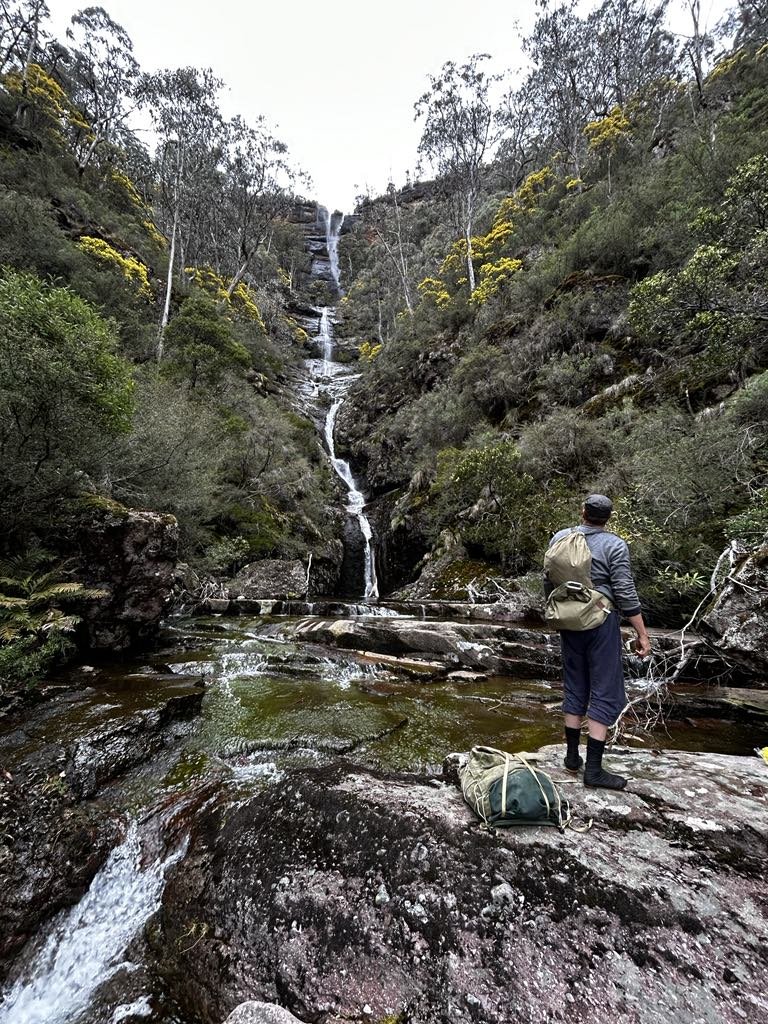A waterfall in Victoria
This is a difficult walk. There is no track and the bush is very thick. Most of the walking is in the creek, where the rocks are slippery with a potential for big injuries in terrain that is difficult to access. Finding the base of the falls requires navigating bush covered cliff-lines, and paying attention to the route for a safe return.
If you're switched on, reasonably fit and able, wear good footwear for slippery rocks and cascades, leave enough time for difficult route finding, and carry spare clothes and gear for accidents and emergencies, the reward is spectacular.
Clothing and equipment
Shoes: Tabbi boots or volleys
Holger wore the iconic canvas dunlop volley with canvas gaiters. I wore canvas tabi boots. Both have excellent grip on wet rocks, and are light and good in water. The tabis have better sensitivity and the toe split gives excellent security in lateral movement. The volleys are made of tougher canvas, and the rubber sole is more substantial, offering slightly better protection to the feet, but slightly less sensitivity. Both are light weight and shed water quickly. The tabis shed the water better. Canvas gaiters or putties are a wise addition on this walk, to protect against scrub, rocks and possible snakes.
Main clothing: Hemp/cotton knits
My main layer of clothing were hemp/cotton knit long sleeve top and long pants. Think tracksuit, but natural fibre. This was excellent! Knit fabrics are very comfortable and have no restriction of movement whatsoever. The sleeves and legs can be quickly pulled up to avoid saturation in the water. Their loose fit and high moisture absorbency offer great sweat management, keeping my body comfortable. The fibre keeps me cool in the heat, and warm, even when wet, if I wear an insulating mid layer over then, like a sweater and wool pants. The hemp/cotton knit is strong enough to offer adequate protection in these conditions. I carried a spare pair in my bag for if we had to stop for an extended period of time.
Warm mid layer: Possum/merino/silk knit sweater
As the temperature was 5- 15 degrees celsius, with a slight wind with approaching rain, the atmosphere was cool and humid. Perfect for strenuous walking, but challenging in the wet. Over my hemp/cotton knit top, I wore a possum/merino/silk knit sweater most of the time. This is a very light weight sweater, yet warmer than merino sweaters twice the weight. It is also very soft on the skin, so can be worn by itself with comfort.
In my opinion, it is better to have medium weight woollen knits as a mid layer than to have lighter wool knit as a base layer. As a medium weight mid layer, they insulate the more absorbent hemp/cotton knit base layer, keeping that warm if needed. If the hemp layer becomes saturated and a problem, the possum knit is soft enough to wear on its own comfortably. This combination also means more options. Hemp/cotton knits on if it’s hot or strenuous, mid layer possum knits if wet and cold.
Spare clothes: Hemp/cotton knits, wool weave pants and cowl, wool socks, waxed canvas anorak
In my packs I carried spare clothes for stoppages, unintended stays or cold wet conditions. I had a dry set of hemp/cotton knits for their comfort and versatility. Wool weave melton pants and a skjoldehamn cowl (currently in development) for moderate rain and cold. The waxed canvas anorak was for cold, wind driven, heavy rain, but also for a ground sheet or small tarp. The cowl was an excellent cover on the return, whie the moderate rain fell and fatigue started to set in. It’s just enough kept the head, neck and shoulders warm and dry, but not so much as to be heavy or bulky, or to risk over heating.
Packs: Canvas frame pack, backsack and bum bag
Frame pack
A frame pack is a bit more than necessary for a day walk, but it has the capacity for carrying a bigger load, such as if anyone was injured on the trip and the other person had to carry both people’s gear. It is also very useful for gathering firewood, and as a seat or ground sheet. So I carry a frame pack for potential scenarios.
Bumbag
On my waist I carry the canvas roll top bum bag, which carries my possum knit sweater, a water bottle, some food, a camera, drawing gear, a fire kit and basic first aid and emergency beacon. It is a very handy, do everything bag that normally clips to my waist, either in front or behind, or slung over the shoulder. When I wear it behind on my waist it helps support the weight of the canvas backsack, but when I am carrying the frame pack I position the bum bag in front for easy access while walking.
Backsack
The backsacks are organiser bags inside larger carries like the frame pack or kit bag. On trips like this, they have the added benefit of becoming a day pack for side trips. On this trip, I dropped the frame pack at the base of the falls, reorganised my kit and carried the bum bag with backsack up to the mid section of the falls.
Thanks
To Holger Galoch, an extraordinary adventurer, all his life. leading me into remote and wonderful areas, walking deep into the Kimberley & hidden canyons of Victoria. He's helped me through extremely difficult chapters in life, and shown me the value of solitude. Long may you be in this world Holger.







